Suzan Mazur: John Deuss - The Manhattan projects
Deuss: The Manhattan projects
By Suzan Mazur
First Published By The Mid Ocean News
Bermuda Tuesday, September 20, 2004
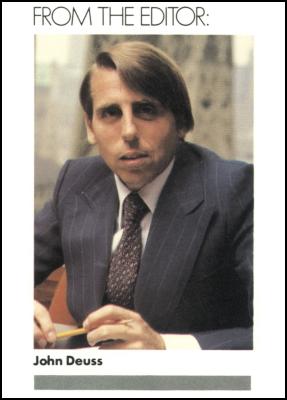
Click for big version
John Deuss – Oil Baron, Purveyor Of Fashion, Publisher
IT'S been a while since I've had a conversation with Bermuda-based oil maverick John Deuss. But what comes to mind after reading about the fatal helicopter crash of Group Menatep's managing director (turned intelligence agency informant), Stephen Curtis, is the response to a question I once put to Deuss as to whether government or organised crime really runs things. At the time of Curtis' death, he was also a director of Bermuda Commercial Bank, the bank chaired by Deuss.
"It's close," Deuss said, sometime towards the end of the Reagan Administration.
I've been wondering how he might answer that question now . . .
An Internet NameBase search puts John Deuss squarely in the know. Run his name through that database and you end up with Deuss at the centre of a corporate and espionage spiderweb that links him directly to Research Associates International, run by the late Vietnam spymaster Ted Shackley (the infamous "Blonde Ghost" who co-ordinated anti-Castro attacks on Cuba prior to the Bay of Pigs and ran the undeclared wars in Laos and Cambodia that became bloody sideshows to the US military involvement in South Vietnam). Deuss hired Shackley after he left the Central Intelligence Agency in 1979 to organise shipments of oil to South Africa, then under a global oil embargo that Deuss cheerfully flouted.
And through Shackley, Deuss is linked with some of the most controversial names in recent history: Rogue CIA agent Edwin Wilson, Thomas Clines, John Singlaub, Philip Agee, Manucher Hashemi, Rafael (Chi Chi) Quintero and even Australia's CIA-linked/arms-dealing/narco-trafficking Nugan Hand Bank.
Names that summon the words of dying spy chief James Angleton, as told to Joe Trento: "Fundamentally, the founding fathers of US intelligence were liars. The better you lied and the more you betrayed, the more likely you would be promoted. These people attracted and promoted each other. Outside of their duplicity the only thing they had in common was a desire for absolute power . . . Allen Dulles, Richard Helms, Carmel Offie, and Frank Wisner were the grand masters. If you were in a room with them you were in a room full of people that you had to believe would deservedly end up in hell. I guess I will see them there soon."
However, such a "six degrees of separation" name game can prove seriously misleading.
"Shackley worked for John, not the other way around," one of Deuss' long-time business associates reminded me as he sat reading to me from Carl Bernstein's article The CIA and the Media in the amber lights of the Harvard Club.
So to better understand the significance of the Deuss/Curtis connection, I decided to revisit my own archives . . .
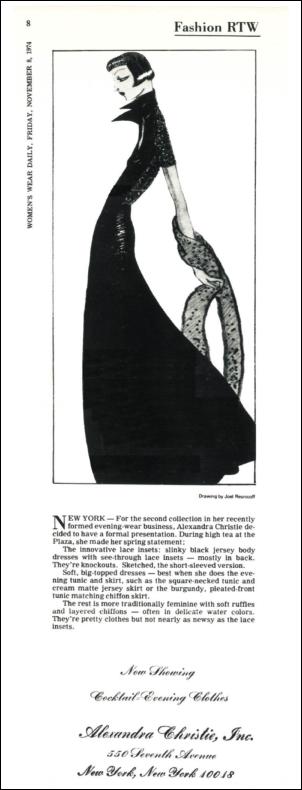
Click for big version
John Deuss's Fashion Label - Alexandra Christie
IN 1974, when Rudi Gernreich was dressing his models in bicycle parts, a Dutch oil trader named John Deuss quietly opened an expensive evening dress collection on Manhattan's Seventh Avenue in the same building with Geoffrey Beene and Bill Blass. He called the company "Alexandra Christie".
It was a subsidiary of his fledgling JOC Oil company, which he'd started the previous year, fuelled by the OPEC oil embargo. He gave up his position as a used car salesman in Amsterdam to do so. A year on, Deuss was being touted as the "world's most important independent oil trader".
I was the model for Alexandra Christie, on hiatus from starvation as a writer/editor at Hearst magazines, where my environment column had been killed by the gun lobby. I was hired by the assistant designer, who I'd met at another fashion house. He largely designed the collection since the star designer was having emotional problems.
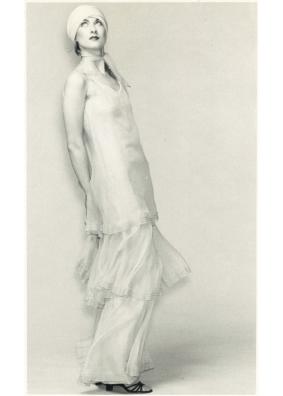
Click for big version
The Author – Circa 1970
Alexandra Christie featured gossamer dresses in "delicate water colours" with layered skirts, ruffles and ribbons, and an array of slinky silk jerseys. The signature piece for spring was a black cocktail length dress with see-through lace back.
But with all the social upheavals taking place in America at the time, these "society" numbers were not selling wildly. The company quickly became a curiosity to fashion insiders who were more interested in finding out who the "backer" was than writing orders.
Few ever found out. Deuss never made an appearance at Alexandra Christie. Even at the Plaza Hotel "high tea" presentation, Deuss was missing. The story was that he was in Qatar, en route to the Soviet Union. And that JOC Oil was already worth $2 billion.
In fact, it was only after I helped Deuss close the fashion company in 1975 that we actually met. The decision to terminate was precipitated by the designer's emotional collapse.
To show his appreciation, Deuss invited me to dinner at Lutece, the finest restaurant in New York. He also threw in the dresses. I was then modelling for Giorgio Sant Angelo, the designer who dressed Verushka for the cover of Vogue. I invited an Italian model to join us.
Deuss invited John Hoey, a Riyadh-based investment banker who had just returned from Vietnam where he'd been a foreign service officer at the US Embassy in Saigon - a compound shared coincidentally by CIA station chief Ted Shackley.
HOEY co-wrote the assessment book on US pacification efforts while in Vietnam. He later went into the oil business, serving as President of Hondo Oil as well as Atlantic Refining, and is now a Director of Tethys Oil in Stockholm.
Deuss and Hoey were a highly entertaining and unique duo. Deuss seemed even younger than 31 because he was so animated. His quick mind was sublime - and upstaged the mastery of his tailor.
He had the wiry physique of a tennis player, which he was. His eyes changed too rapidly to get more than a hint of what he might really be thinking, but they were open and generous. There was a dramatic scar on the back of his head.
Though just a few years older, Hoey appeared more contemplative, having seen war up close. There was a resemblance to Sean Connery as Bond somewhere under the beard he'd grown in order to blend in with the Saudi culture. He told me that he'd been a fullback at Notre Dame.
Deuss called him "Froggy", a name I've never attempted to decode.
It was a spirited encounter. Deuss was fond of Tattinger in those days and Hoey, mad about Cuban cigars, which he passed around the table.
I remember visiting Deuss subsequently at JOC Oil headquarters in the Olympic Towers. His office was a sparsely furnished room. He was seated at a desk against the wall with a computer on top to his left. I recall seeing a framed Mid-East artifact.
He had one eye on the screen as I entered and continued to monitor the computer even as we spoke. Not a lot of people had computers on their desks in the mid-'70s, and since he was not open about what he was viewing, I felt a bit uneasy. I'd learn many years later that he was simply running programs.
He had a lovely, raven-haired secretary named Camille, who I remember dressed in cashmere with silk scarf, probably Hermes. She was married, completely professional and was never rattled.
A few months later, Deuss invited me to a party at his Hamilton, Bermuda residence. I flew from New Jersey's Butler Airfield in his Lear jet. Some guests were already at the house - which was modestly furnished - when I arrived. Most were company employees. Also in the mix were two Liberians attached to the Tolbert regime who later fled the 1980 coup in which Tolbert and his ministers were stripped, tied to trees and shot.
I was beginning to get a sense of how Deuss put together his deals - Liberian-registered tankers would clearly be useful.
However, contrary to what Dutch journalist Friso Endt has written about Deuss' Bermuda headquarters, I don't recall seeing girls lounging in bikinis. Deuss' first wife, a writer, was present during one of my two trips to Hamilton. His tennis pro, Rafael, always smiling, was there for anyone interested in a match or instruction. The atmosphere was relaxed, unpretentious, though everyone dressed for dinner at the Southampton Princess.
There is no question that Deuss has the classic male E-brain for business, but with friends he was disarmed. I can still see him, Bogart-like, at the wheel of his cruise boat attempting to sing the popular Lebanese song Susannah!
We might never have met again, except that I booked out for the New York spring fashion shows in 1976 and joined a "Bicentennial Collection Tour of the Middle East", going to Kuwait and Iran. It was partly sponsored by the Al-Sabahs and Pahlavis and had the blessing of the US State Department.
Many of the designs were American "couture" selling for $2,000-$6,000 a dress - from Scaasi, Sant Angelo, Trigere, etc. The jewels from David Webb were real. We were accompanied by executives from Estee Lauder.
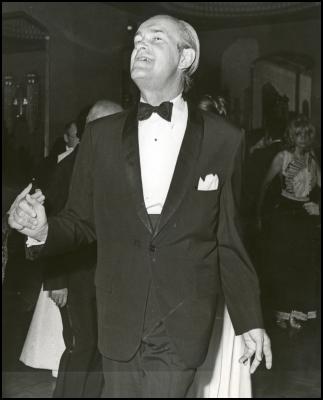
Click for big version
Ambassador Richard Helms – Image From The Suzan Mazur Archives
FORMER CIA Director Richard Helms was then Ambassador to Iran (George H.W. Bush was then CIA director). Helms attended our fashion gala at the Royal Tehran Hilton, which later served as headquarters for the Iranian revolution. The show was a benefit for the Empress' mother's favourite charity - the Children's Convalescence Home.
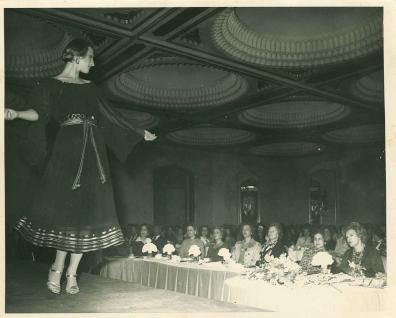
Click for big version
Caption: Suzan Mazur on the Royal Tehran Hilton runway wearing Giorgio Sant' Angelo pleated chiffon peasant dress with Iran's Queen Mother, Madam Farideh Diba (far right) and Cynthia Helms, wife of US Ambassador Richard Helms (third from right) looking on. -- April 1976, Photo: Peter and Florence Mazur Archives"
In Kuwait, we were honored with a state dinner following shows at the Equestrian Club (later temporary JIB headquarters during the Gulf War) and at the American Embassy. Possibilities were being explored for a show in Saudi Arabia as well. I received a telex at the Kuwait Sheraton from John Hoey, who had returned to Riyadh. It said:
"Regret unable to come to Kuwait, but hope your presentation is a success. Timing is too short to arrange anything in Saudi Arabia, but notified colleagues in Saudi Arabia who expect to attend the Kuwait presentation. Regards."
As a result of what turned out to be a "quasi-official" tour, I met the important merchant families, an array of international diplomats and everyone else.
My photograph appeared on the front page of the Kuwait Times, which I sent to Deuss, which kept me in his "rolodex" and on his Christmas card list.
About six months later I wanted to fly to Paris because I had interviews at Givenchy and Ungaro. I asked Deuss if I could catch a ride if he was heading in that direction.
He told me he had to fly to Iraq first, and that if I could arrange a visa to Iraq, I could join him. He'd then fly me back to Europe.
Iraqi visas were being handled at the time by the "Iraqi Interests Section" of the Indian Embassy in Washington. But a friend from Kuwait pulled some strings and I secured a one-week visa, indicating reason for travel: "Giorgio di Santa Angelo" (sic) fashions.
I got a call from Deuss' secretary, Camille, asking me what kind of food I'd like for the trip. But an hour or so before departure, Deuss' itinerary changed. He called to apologise, and instead facilitated my commercial flight.
It was during my second visit to Bermuda that Deuss told me about the rooftop explosives accident he had as a teenager, which resulted in a serious head injury. It had to be one of the defining episodes of his life. At age 14 he looked into the face of death and won.
Deuss told me his grandfather was a physicist, and I got the impression that he may have been trying to emulate him when disaster struck. He also said his father had been a manager at General Motors in Amsterdam (Friso Endt claims it was general motors - a garage in Nijmegen, Holland, and The Wall Street Journal reports it was Ford Motor Co.) and that he sometimes accompanied his father to the office.
Two former Vietnam military pilots flew me back from Bermuda. I was the only passenger because I had a fashion booking on Monday morning and other guests were taking a long weekend. I was going to be nearly an hour late, so I called in to the Manhattan showroom from the jet as we approached Butler airfield. In the late 1970s people did not call in to work from jets. I confounded the showroom manager, and subsequent bookings were cancelled.
Some months later, I was surprised when Deuss and his date sat down at a table next to me at Regine's, the Park Avenue nightclub. I was having dinner at the time with Mahmoud Alghanim, a man of substance and style from Kuwait's most prominent merchant family. He was also a shareholder in Kuwait's only independent oil company.
I was delighted at the coincidental meeting. But Alghanim seemed less than enthused when Deuss offered his business card. Deuss was already recognised as "one of the sharks" by the Gulf Arabs.
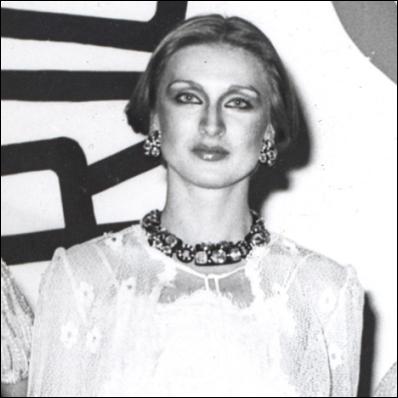
Click for big version
The Author In The Middle East
AROUND this time, Deuss began pumping money into a magazine he called Chief Executive, which shared offices with his oil company, now renamed Transworld Oil. Deuss held the positions of editor/publisher, CEO and chairman of the board; John Hoey was vice-president. The Deuss/Hoey business relationship and friendship continued to blossom.
The magazine resembled Aramco World in layout and quality of paper stock. It reached "a limited list of 25,000 distinguished world leaders" and some of the same people were profiled. Lavish full-page ads were dropped in from Gulf Oil, McDermott, Bell Telephone, Canadair, Medafrica Cargo, the Arab African International Bank and Paris' Hotel George V.
Under Deuss' ownership Chief Executive was published four times a year. (It was sold over a decade ago.) Each issue began with a Deuss editorial, e.g., "Age Is No Barrier; Youth Is No Bargain" about then Governor Reagan's age of 69 possibly handicapping his presidency, if elected. Deuss didn't think Reagan's age was of consequence.
His spring 1978 editorial, "The Quest For Harmony", discussed the agreement signed in Rhodesia paving the way for majority rule. Rhodesian Prime Minister Ian Smith was on the cover. Deuss wrote:
"As chief executive of his country, Prime Minister Smith made the decision to settle for what was practical and most expedient. Ian Smith does not believe in majority rule. But he accepts the fact that universal adult suffrage in Rhodesia can no longer be postponed." (The next year Deuss and Shackley would team up on oil shipments to South Africa.)
Chief Executive features included one titled "The Most Dangerous Corporate Game" about the perils of businessmen paying bribes abroad; it was written by Ted Sorensen, JFK's Special Counsel who was then a partner at Paul, Weiss. Another presented a point by point "security threat analysis" regarding the safety of CEOs.
Iain Murray, Duke of Atholl, a CEO with his own private army, was given six pages with a two-page photo of the Highlanders marching in kilts with "goatskin sporran". There was an interview with Lynn Salvage, President, The First Women's Bank. And a visually stunning article on "Understanding Islam" from Malcom Yapp of London's School of Oriental and African Studies offering the following prescient wisdom:
"For the West, patience and an insurance policy in the form of a diversification of energy supplies would probably be better protection against Islamic revivalism than a big stick. In the meantime, we should try to understand the revivalists and sympathise with them. Infuriating as they seem and as savagely as they behave, they have an ideal - modernisation with morality: the creation of an urban society without losing the values of an older and simpler one. Many share this ideal."
I RECEIVED a note from Deuss in 1981 after I'd resumed my career in journalism and recently published a feature interview with Malcom Forbes in Omni magazine - which Forbes insisted on reprinting as a five-page centrefold in Forbes. Deuss had also just profiled Forbes in Chief Executive and enclosed a copy.
Then we lost touch for a few years. But, in 1987, I proposed a profile of him for Lear's. It was a new magazine for women. I think he may have thought it was a lifestyle magazine involving CEOs and aviation.
Deuss had been dubbed the "mystery man" in a New York Times article the previous year. The article tracked his buying up of East Coast oil refineries for Transworld Oil Ltd. But he had still not come forward to sit for a portrait.
He finally agreed to discuss the possibility of doing so with me over lunch across the street from his office, at La Grenouille, the most flattering restaurant in New York because of its flowers and mirrors, and also the most delicious.
He ordered a bottle of Pouilly Fuisse to toast old times, even though he was no longer drinking. The lunch lasted exactly 45 minutes. And there was a car waiting outside to take him to his next appointment. His decision regarding the story was that Lear's was "not sexy enough" a format.
His big profile would come in 1995 in a page one Wall Street Journal article subtitled: "Is John Deuss a Visionary or a Slick Operator? He Holds Key to the Project." It discussed his brainchild Caspian Pipeline Consortium and attempts by Chevron to push him out.
So what does this all say about who Deuss is now in relation to Curtis? I conclude that Deuss remains his own man - like the Duke of Atholl with the motto: "Furth, forth and fill the fetters ("Go forth, be lucky and take plenty of prisoners)." Yes, he should not be underestimated.
SUZAN MAZUR is a New York-based journalist.
Her reports have appeared in The Economist, The Financial
Times, Forbes, Philadelphia Inquirer and Newsday, among
other publications, as well on PBS, CBC and MBC. She has
been a guest on McLaughlin, Charlie Rose and various Fox
television news programmes. Ms Mazur worked for
Bermuda-based oil baron John Deuss in the 1970s and the
following profile is based on her first-hand impressions of
the controversial and elusive chairman of the Bermuda
Commercial Bank. She can be contacted at sznmzr@aol.com


 Binoy Kampmark: Gender Stunts In Space - Blue Origin’s Female Celebrity Envoys
Binoy Kampmark: Gender Stunts In Space - Blue Origin’s Female Celebrity Envoys Richard S. Ehrlich: A Deadly Earthquake & Chinese Construction
Richard S. Ehrlich: A Deadly Earthquake & Chinese Construction Ian Powell: It Does Matter To Patients Whether They Are Operated In A Public Or Private Hospital
Ian Powell: It Does Matter To Patients Whether They Are Operated In A Public Or Private Hospital Gordon Campbell: On Marketing The Military Threat Posed By China
Gordon Campbell: On Marketing The Military Threat Posed By China Binoy Kampmark: Olfactive Implications - Perfume, Power And Emmanuel Macron
Binoy Kampmark: Olfactive Implications - Perfume, Power And Emmanuel Macron Martin LeFevre - Meditations: True Abundance
Martin LeFevre - Meditations: True Abundance